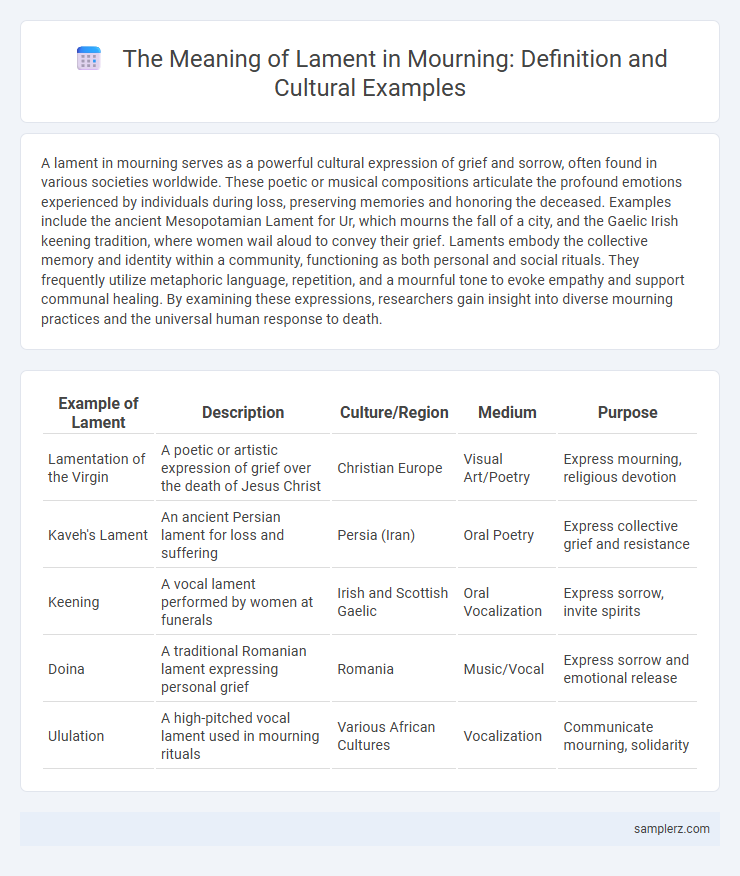A lament in mourning serves as a powerful cultural expression of grief and sorrow, often found in various societies worldwide. These poetic or musical compositions articulate the profound emotions experienced by individuals during loss, preserving memories and honoring the deceased. Examples include the ancient Mesopotamian Lament for Ur, which mourns the fall of a city, and the Gaelic Irish keening tradition, where women wail aloud to convey their grief. Laments embody the collective memory and identity within a community, functioning as both personal and social rituals. They frequently utilize metaphoric language, repetition, and a mournful tone to evoke empathy and support communal healing. By examining these expressions, researchers gain insight into diverse mourning practices and the universal human response to death.
Table of Comparison
| Example of Lament | Description | Culture/Region | Medium | Purpose |
|---|---|---|---|---|
| Lamentation of the Virgin | A poetic or artistic expression of grief over the death of Jesus Christ | Christian Europe | Visual Art/Poetry | Express mourning, religious devotion |
| Kaveh's Lament | An ancient Persian lament for loss and suffering | Persia (Iran) | Oral Poetry | Express collective grief and resistance |
| Keening | A vocal lament performed by women at funerals | Irish and Scottish Gaelic | Oral Vocalization | Express sorrow, invite spirits |
| Doina | A traditional Romanian lament expressing personal grief | Romania | Music/Vocal | Express sorrow and emotional release |
| Ululation | A high-pitched vocal lament used in mourning rituals | Various African Cultures | Vocalization | Communicate mourning, solidarity |
Understanding Lament: Cultural Interpretations of Mourning
Lament in mourning serves as a profound cultural expression of grief, often ritualized through mournful songs, poetry, or vocal outcries that convey sorrow and communal loss. Various cultures interpret lament differently, with examples such as the keening tradition in Irish culture, which involves mourners wailing aloud to honor the deceased and facilitate emotional release. Understanding lament reveals its role in connecting individuals to collective memory and spiritual beliefs surrounding death and afterlife.
Historical Examples of Lament in Mourning Rituals
Historical examples of lament in mourning rituals include the ancient Mesopotamian practice of professional mourners who chanted dirges to honor the deceased. In Celtic traditions, keening involved vocal lamentations expressing grief and inviting communal participation in the mourning process. These culturally specific laments served both as emotional outlets and as mechanisms to navigate death and loss within society.
Traditional Lament in Indigenous Cultures
Traditional lament in Indigenous cultures often involves vocal expressions of grief that convey deep emotional and communal loss. These laments include repetitive wailing, singing, and poetic storytelling that preserve ancestral memories and strengthen cultural identity. Specific rituals, such as the Navajo "hozho" chants or the Maori "waiata tangi," exemplify how lament serves both spiritual and social functions in mourning practices.
Music and Poetry as Expressions of Grief
Music and poetry serve as profound expressions of grief in mourning rituals, capturing the depth of sorrow through haunting melodies and poignant verses. Traditional laments, such as the Arab "Muwashshah" or Irish keening songs, use rhythmic patterns and evocative language to convey collective and individual loss. These artistic forms not only preserve cultural heritage but also provide emotional catharsis, enabling communities to process mourning through shared creative expression.
Women’s Role in Lamentation Practices
Women historically serve as primary mourners in various cultures, articulating grief through communal lamentation songs that preserve oral traditions and express collective sorrow. These lamentations often incorporate specific vocal styles, gestures, and repetitive phrases that convey deep emotional resonance and cultural identity. By leading mourning rituals, women facilitate emotional release and reinforce social bonds during times of loss.
Lament in Religious Mourning Ceremonies
Lament in religious mourning ceremonies serves as a vocal expression of grief and spiritual supplication, deeply rooted in cultural traditions such as the Jewish Kaddish prayer and the Islamic recitation of Al-Fatiha during funerals. These laments often incorporate poetic elements, chanting, and repetitive phrases that convey sorrow while seeking divine comfort and forgiveness for the deceased. The presence of lamentations in rites like the Christian Office of the Dead and Hindu Shraddha rituals highlights their significance in communal mourning and religious continuity.
Modern Adaptations of Ancient Lamenting
Modern adaptations of ancient lamenting often appear in contemporary music genres such as blues and hip-hop, where artists express grief through poignant lyrics and soulful melodies. Digital platforms enable the fusion of traditional mourning songs with electronic sounds, preserving cultural heritage while reaching global audiences. These adaptations maintain the emotional intensity of historical laments, serving as powerful tools for communal healing and remembrance.
Regional Variations in Lament Customs
Lament customs in mourning exhibit distinctive regional variations, such as the keening tradition in Ireland, where mourners wail and sing dirges to express grief collectively. In parts of West Africa, griots perform oral laments combining song and storytelling to honor the deceased's legacy. East Asian cultures, including Japan, incorporate silent, ritualized laments emphasizing restraint and spiritual reflection during funeral ceremonies.
The Psychological Impact of Lament in Mourning
Lament in mourning serves as a powerful emotional release, facilitating the processing of grief and reducing psychological distress. Expressing sorrow through lamentation activates neural pathways linked to emotional regulation, promoting healing and resilience. This cathartic practice helps mourners find meaning in loss, mitigating feelings of isolation and depression.
Preserving Lament Traditions in Contemporary Culture
Lament traditions, exemplified by the Kurdish elegy "Kilame Serxwebune," play a crucial role in expressing collective grief and preserving cultural identity in contemporary mourning practices. These oral expressions, deeply rooted in historical and social contexts, serve as vital links connecting past generations with present communities. Efforts to document and revive lament rituals through festivals, digital archiving, and educational programs ensure their sustained relevance amidst modern cultural shifts.

example of lament in mourning Infographic
 samplerz.com
samplerz.com